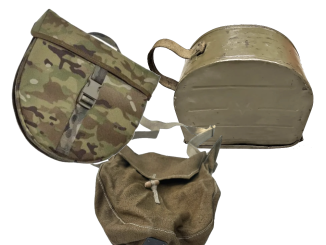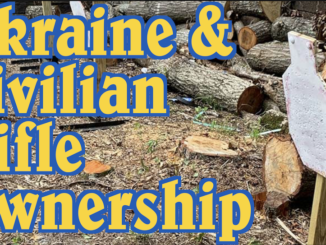The initial Russian invasion of Ukraine in 2014 stagnated into trench warfare after a few months, and Ukrainian forces found themselves often in entrenched positions 500m or more from Russian opposition. At that range, their PKM .30-cal machine guns were not really effective, but .50 caliber guns were. And so, they started a program of retrofitting DShK heavy machine guns with muzzle brakes (initially designed for NSV machine guns on light tripods), bipods and shoulder stocks to use as support weapons. These could be effective against targets like vehicles and strong points up to 1000m when used with good optics (or spotters with optics). Later versions also added a pistol grip and conventional trigger, instead of using the original spade grip triggers. Fitted out like this, the felt recoil is roughly equivalent to shotgun firing light birdshot loads.
DShK machine guns were standard equipment on Soviet tanks and other vehicles in the early part of the Cold War, used as antiaircraft machine guns. There is little practical AA use of this type of heavy MG against modern aircraft, and I suspect Ukraine had a significant number of them on inherited Soviet vehicles.
This footage comes from two joint US/Ukrainian training exercises, in September 2017 and February 2018. I’m sure the guns are still in use right now, and I suspect they will show up in publicized footage sooner or later. The still photos are from fighting in eastern Ukraine in 2017 (I mistakenly said 2015 in the video).
The appearance of U.S. Department of Defense (DoD) visual information does not imply or constitute DoD endorsement.




SLAVA UKRAINIA! I’d like to point out three things
1) I was taught as a wet behind the ears Second John that the 50 Caliber on my tank was to be use4 for AA purposes and to engage light armor such as recon vehicles (BRDM) and APC’s (BTR-40, BTR-50, BTR-152, BTR-60, BTR-80, MT-LB)). After all, Black Jack Pershing wanted a weapon that would be effective both as an AT or AA gun and John Moses Browning did a darn good job of satisfying the customer. IIRC, the Russian 12.7mm (“51 Caliber” of Vietnam) is at least as powerful as 50 BMG, maybe more so. So I can see these being used to bushwack Russian columns that are canalized by terrain or obstacles such as mines and tetrahedrons, as well as antipersonnel use.
2) The PAVN and VC made effective use of the Dushka against US helicopters in Vietnam and the 50 Browning is retained for the same purpose. The idea is for the tank platoon or company to put up “a wall of steel”. to quote the manual that the enemy aircraft is forced to fly through. And whether or not you shoot down the aircraft is immaterial, the idea is to make the pilot miss. This is what the Chieftain has to say about tank versus aircraft, https://www.youtube.com/watch?v=AirRXwbo8Mg&t=416s
3) The harmonica muzzle brake reminds me of the one on the Boys AT Rifle
http://liamgrice.blogspot.com/2013/07/i-made-this-boys-anti-tank-rifle-while.html
In Vietnam, helicopters were using unstabilized machine guns and unguided rockets, which pretty much required them to close within 12.7mm range to be effective. Modern attack helicopters are much more likely to be using light cannon in stabilized turrets with good optics, and guided missiles. They don’t have to fly through the “wall of steel”, and they’re not even going to be distracted by tracers that burn out before they reach them.
The US-experimental layout takes the sensible approach that a long enough receiver can combine shoulder firing with a reasonable OAL, yet without the issues typically associated with bullpups.
The DShK modification OTOH is like the “Let’s make our MMG into an ‘LMG’ by making it longer and more awkward” 1919A6, taken to the next level.
This DShK modification is more like, well we gave a lot of DShK so let’s try to make a Kord on bipod without any Kord.
…’we have’… not ‘we gave’… nasty autocorrect
Making a long gun much, much longer (with zero necessity or advantage) either way.
I think Russians and Ukrainians are willing to accept extra lenght in exchange of losing some weight compared to tripod.
After all roughly 2 meters long is comparable to PTRS and PTRD anti material rifles of WWII fame.
If the situation was that binary, sure.
and there is one certain guy who…
any idea what those bullpuppy ak’s in use are? or BP svd versions would be interesting.
“(…)what those bullpuppy ak’s(…)”
There at least 2 models of Ukraine made bull-pup fire-arm derived from Kalashnikov automaton.
Malyuk https://modernfirearms.net/en/assault-rifles/malyuk/
Vepr https://modernfirearms.net/en/assault-rifles/ukraine-assault-rifles/vepr-eng/
Former existing in 7,62×39, 5,45×39 and 5,56×45 versions, latter is always 5,45×39.
Consult photos in mentioned articles to detect which one did you have encountered.
I may be mistaken but I don’t think we’ve seen Vepr, it was all Malyuks. Your articles also mention that Vepr was never formally procured, while Malyuk was. I doubt that after 2015 they were producing new Veprs.
“(…).50 caliber guns were. And so, they started a program of retrofitting DShK heavy machine guns with muzzle brakes (initially designed for NSV machine guns on light tripods), bipods and shoulder stocks(…)”
Hmm, .50 caliber, lightweight mount and should stock machine gun?
Interestingly this fits Beardmore-Farquhar 0.5-inch caliber machine gun see 3rd image from top http://modernfirearms.net/en/machineguns/great-britain-machineguns/beardmore-farquhar-eng/
So not only U.S. dwellers entertained such idea during 1930s. It must be noted that this gun consumes 12,7×81 mm ammunition, it is weaker that both 12,7 x 99 and 12,7 x 108 mm.
I realize this a “firearm history club” but have you noticed from available videos on ground that the firearms do relatively tiny amount of damage? The most damage by far is done with:
– ATGMs
– MANPADS
– autonomous pilotless vehicles
– combat helicopters
As a matter of fact I’s say the curiously enough it is an infantryman who is the lord of the battlefield. And please do not get excited, I do like you century old “dusha”; I saw them in museum and war movies when I was ten. Time has moved on; the killing methods are lot more efficient nowadays.
Warfare is evolving into a contest between armored machines. It began a century or so ago and has had that long to develop. In human evolution terms, that’s the time range between Homo Erectus and Homo Sapiens (us). Which is the reason tanks of today are a very different thing from a MK I Male, modern combat aircraft are nothing like a Sopwith 1 1/2 Strutter, and back then nobody would have dreamed of an AH-64.
By comparison, a modern automatic rifle isn’t much different from the ones of 1918. What differences there are, are largely in details, not fundamental design principles.
That being said, infantry with weapons capable of damaging or destroying those machines are still a credible threat on the battlefield. And so far, nobody has figured out how to kill every single grunt in the target area.
Hence the USMC axiom;
Only Bring Artillery If You Intend To Kill Everybody.
cheers
eon
That is very much true not just in US Marine corps. Thank you for your valued contribution.
“(…)from available videos on ground that the firearms do relatively tiny amount of damage?(…)”
Be watchful. Image might be distorted by selection of said videos.
“(…)– ATGMs
– MANPADS(…)”
Do work by delivering explosive payload, therefore direct hit is more impressive and thus more likely to get published.
“(…)– autonomous pilotless vehicles(…)”
To my understanding most of these do have onboard camera, thus most hits do have corresponding footage, while most of fire-arms do not have target observing camera, thus footage of successful usage might simply do not exist.
Artillery (not a major focus on that channel) was killing more men than infantry weapons in wars between or withing industrialized nations for more than 200 years.
In general if you listen if you listen to Ian when he is asked about how such a nation could theoretically improve their arms at such a time, or when he is opining on comparable virtues of historical firearms his opinion seems to be that from a purely military standpoint the most important quality of infantry rifle is to be there. For that end it must be a) reliable b) cheap c) that’s it. If today even machine guns are reduced to the role of “being there” it still nothing new, conceptually.
Note however that even if rifles inflict only a small part of the enemy’s casualties that still does not mean you can get rid of them – they are discouraging the enemy from certain tactics that would be devastatingly effective if only machine guns were left. Same with machine guns today – even if they are not being used much they are still necessary.
I believe the DShK’s are 51 caliber. Correct me if I’m wrong.
It is 12,7-мм as evidenced by manual https://coollib.com/b/355169-ministerstvo-oboronyi-sssr-127-mm-pulemetyi-obr-1938-46-g-i-1938-g-nastavlenie-po-strelkovomu-delu/read titled 12,7-мм пулеметы обр. 1938/46 г. и 1938 г. Наставление по стрелковому делу and repairing manual Руководство по ремонту 12,7-мм пулеметы обр. 1938.46 г. и 1938 г. (ДШК), универсального станка обр. 1938 г. и зенитных прицелов обр. 1943 г
Both are .50 calibers: 12.7×108 bullet is .511 diameter compared to.512 for 12.7×99.
I think the 51 caliber moniker came from Vietnam era US intelligence reports to avoid confusion with 50 BMG.